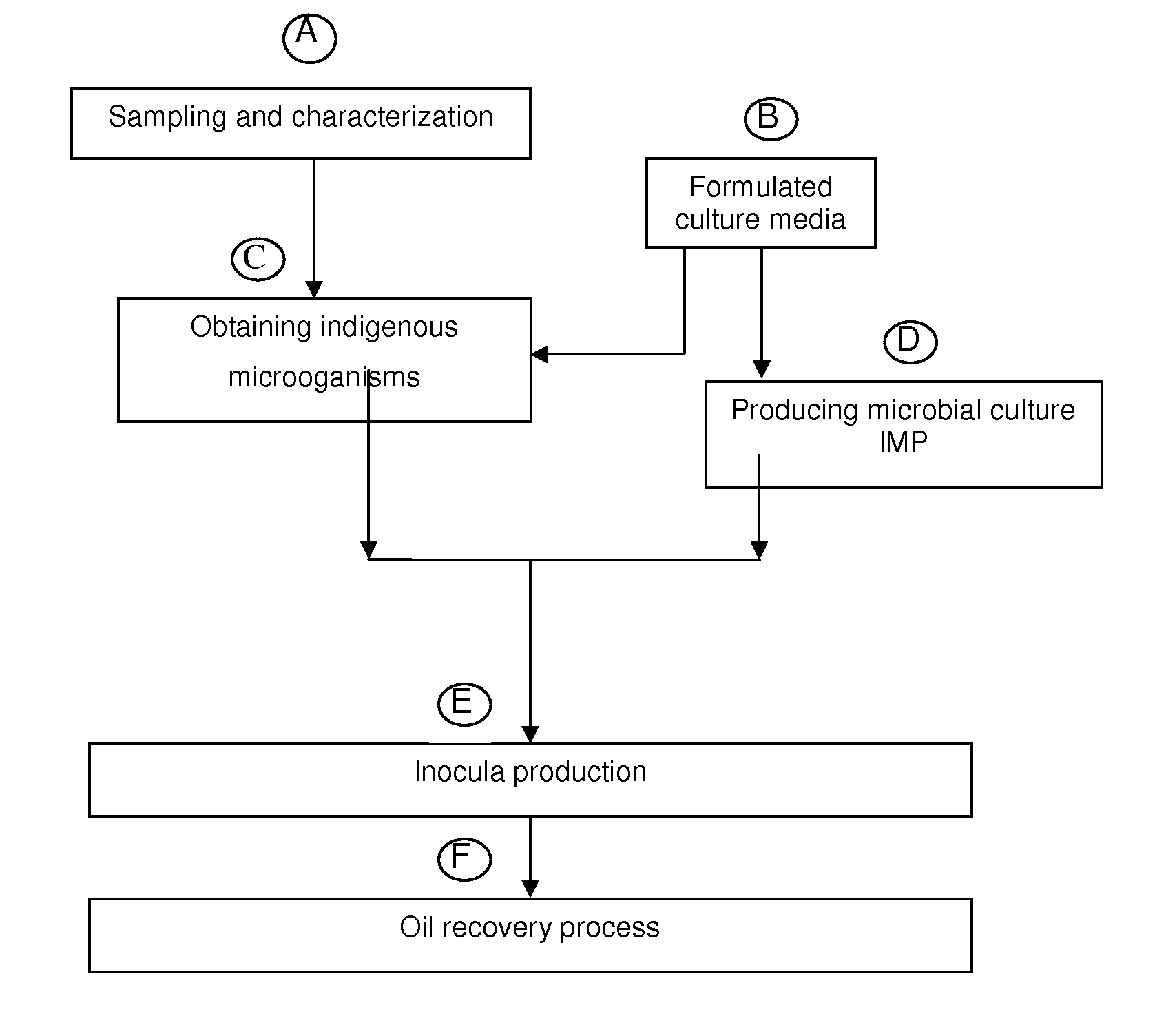Biotechnological process for hydrocarbon recovery in low permeability porous media
a biotechnological process and hydrocarbon recovery technology, applied in the field of biotechnological processes, can solve the problems of insufficient supply of prior technologies in the application field, and achieve the effects of enhancing oil recovery, low permeability, and increasing oil mobility
- Summary
- Abstract
- Description
- Claims
- Application Information
AI Technical Summary
Benefits of technology
Problems solved by technology
Method used
Image
Examples
example 1
In Non Consolidated Porous Media Using Microorganisms
[0059]Oil recovery was evaluated, using porous media obtained from clayey sandstone and / or carbonate-containing rocks. The rocks were ground, meshed and selected, based on the corresponding size, from 200 to 500 μm. 30 g of rock were added per system and covered, sealed and sterilized. The rocks were impregnated up to saturation with oils from 14 to 25° API using vacuum in a N2 atmosphere. Under sterile conditions, the mineral media (Tables 1 and 2), the carbon source, indigenous microorganisms from oils and the IMP culture were added. The systems were incubated at 60-95° C. during 5 to 10 days. The gas production, surfactants, solvents and acids, sugar consumption and oil recovery were determined.
[0060]In the tests performed microorganisms favored oil release, obtaining a recovery above 24%.
[0061]The presence of metabolites was detected in all inoculated systems, (surfactants, gases, acids and solvents), prom...
example 2
Oil Recovery Tests in Consolidated Porous Media Using Microorganisms
[0062]For oil recovery experimental tests, carbonate-containing nucleus were used (10×5 cm), as well as oil from Mexican fields (14-25° API). Core fragments used (10×5 cm) in the experimental cell were rinsed with solvents and vacuum dried at 80° C. temperature. The core composition is synthesized in Table 3.
TABLE 3Chemical composition or carbonated rocksCompoundRock composition %CaCO397.3MgCO30.45Al2O30.55SiO21.7
[0063]The experimental system consisted of a continuous injection pump, an oven for temperature control, transference cylinders, a differential pressure transducer, a data acquisition system and an experimental cell.
[0064]The experimental cell containing the core, was placed inside an oven for temperature control from 60 to 95° C. Transference cylinders were used to displace fluids (brine, oil and inocula) using and injection pump. A differential transducer was installed to monitor pressure drop. A system w...
example 3
[0069]All of the conditions used were identical to those from Example 2, except for the microorganisms and nutrients addition, which was carried out with 3 injection cycles and short confinement periods from 5 to 10 days. The oil recovery obtained by means of the biotechnological process from the present invention was from 20.1 to 24.3%, additional to that obtained through the secondary recovery process.
PUM
 Login to View More
Login to View More Abstract
Description
Claims
Application Information
 Login to View More
Login to View More - R&D
- Intellectual Property
- Life Sciences
- Materials
- Tech Scout
- Unparalleled Data Quality
- Higher Quality Content
- 60% Fewer Hallucinations
Browse by: Latest US Patents, China's latest patents, Technical Efficacy Thesaurus, Application Domain, Technology Topic, Popular Technical Reports.
© 2025 PatSnap. All rights reserved.Legal|Privacy policy|Modern Slavery Act Transparency Statement|Sitemap|About US| Contact US: help@patsnap.com


